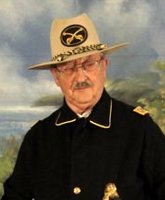The California One Hundred and Battalion
By Richard Duree (Col. Richard Dodge, SASS 1750 Life)
CLICK AN IMAGE TO ENLARGE
Though California was three thousand miles from the battles in the east and separated by at least three months of difficult and dangerous journey, few in California were unconcerned about the conflict. Indeed, sympathies on both sides were at a fever pitch up and down the state and there were concerted efforts by Confederate sympathizers to not only seize California's wealth to finance the Confederacy, but to actually secede from the Union. There were numerous confrontations in towns and cities everywhere, even in the gold fields. Powerful men in government, even the governor, were sympathetic to the Confederate cause.
The enormous wealth in gold passing through Sacramento to San Francisco was an obvious target for secessionists and its diversion to the South could have significantly affected the tide of battle. To counter the threat, a group of German immigrants in Sacramento formed their own local militia in 1857, the Sacramento Hussars, to protect the gold shipments. Sporting a colorful copy of the famed light cavalry units of their native Prussia, the Hussars busied themselves with parades, drills and ceremonies, making their presence obvious to those who would crave the riches passing through their domain. They proudly escorted the first Pony Express rider from Placerville to the terminal on the Sacramento embarcadero and they bore the distinction of never losing an ounce of gold to the Confederacy. In 1888, the Sacramento Hussars became the first unit of the California National Guard.
The U. S. Government had indeed many troops stationed in vital posts around the state, including one on Catalina Island, but many were lonely posts where rampant boredom and lack of opportunity for action, glory and promotion became uninviting assignments.
Remaining on the "home front" was not enough for many patriotic young men who had come to California from the east. They reasoned that if they enlisted in California they would be assigned to one of those mundane posts. Contact was made with Governor Andrews of Massachusetts offering to serve. The governor offered a $200 fee to each man for a one hundred-man unit; they would have to pay their own way to Boston and provide their own uniforms. So they did. Using their enlistment money to purchase their way by ship to Panama, across the isthmus by train and on to Boston, the California 100 arrived in Boston to great fanfare of feasting and parades to become Company A of the 2nd Massachusetts Cavalry.
These Californians were skilled horsemen and fighters, many having worked on the California ranches, hunted the mountains for game, and even fought the Indians in heated skirmishes well before the Indian Wars that followed the Civil War.
Their expertise in horsemanship was immediately recognized, as the urban-raised local troops knew nothing of caring for their mounts. The Californians' knowledge and expertise quickly led to creating an effective and well-trained Massachusetts cavalry.
They were immediately assigned to the army protecting the capital at Washington and were promptly in conflict with their commanding officers, old-line professional soldiers steeped in traditional warfare tactics of patrolling major roads. The Confederate cavalry, led by the likes of Mosby and Stewart, had their way with the trudging Union infantry. It took several hard lessons before the wisdom of the Californians' objections began to take hold and Company A was given free rein to pursue their own type of warfare, much to the Confederate cavalry's dismay and chagrin.
The California 100 were so successful that a call was sent for more volunteers from the west and an additional 400 men arrived – sadly to far less fanfare than their predecessors – and, as Companies E, F, L and M, joined Company A in the defense of the capital. The Californians fought well and valiantly in numerous serious battles, including the terrible Battle of Cedar Creek against Jubal Early's assault on Washington. Armed with the new repeating Spencer carbines, they were instrumental in breaking Early's advance and harassing his hurried retreat. They were proudly in attendance at Appomattox Courthouse when the official surrender climaxed the war.
Of the five hundred Californians who made the difficult trip to Boston from San Francisco and acquitted themselves so well on the battlefield, only 182 were still alive to be mustered out, many suffering from wounds and illness; some were returned prisoners of war from the horrors of Confederate prisons. Many of these survivors were to soon perish as a result of their service. As a final insult from the State of Massachusetts, the Californians were left to their own devices to make their way home to California. It took several months and intervention by the federal government to provide transportation to bring California's patriots home.
Sherman, Wayne; The California One Hundred and Battalion; California State History Museum, Sacramento
Rogers, Larry and Keith; Their Horses Climbed Trees; Schiffer Publishing, 2001
Parson, Thomas; Bear Flag and Bay State in the Civil War; McFarland & Company, 2001
